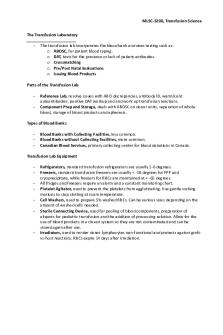Intro to Pharm PDF

| Title | Intro to Pharm |
|---|---|
| Course | Pharm Health Prof |
| Institution | Austin Community College District |
| Pages | 1 |
| File Size | 64.1 KB |
| File Type | |
| Total Downloads | 88 |
| Total Views | 126 |
Summary
intro to Pharm what to expect ...
Description
Nurse Angie 2019
INTRO TO PHARM Phases of Activity
Pharmaceutic phase Pharmacokinetic phase Pharmacodynamic phase.
PHARMACODYNAMIC PHASE Deals with the drugs action and effect on the body. Primary effect: The desired therapeutic effect. Secondary effect: Any other effect the drug has on the body. For example, sildenafil was made for treatment of hypertension. It was also found to help with Erectile dysfunction which is its secondary effect. A drug exerts its action by two main mechanisms. Alteration in cellular function Alteration in cellular environment
PHARMACEUTIC PHASE
PHARMACOKINETIC PHASE
During this phase the drug is dissolved in the body. Liquid medications, sublingual, inhalation, transdermal, and IV medications are absorbed much faster in the body. Tablets or capsules must pass through the GI tract to become dissolved. Enteric coated medications are time released capsules or tablets that must meet the alkaline environment of the small intestine before it can dissolve.
This phase refers to how the drug is transported and distributed. Absorption: moves the drug from the point of administration to the body fluids . Distribution: The systemic circulation distributes drugs to various body tissues. Metabolism: The body changes th drug to be more or less active and excretable. Most drugs are metabolized by the liver, kidneys lungs, plasma, and intestinal mucosa. influenced by age, sex, weight, route, & disease Excretion: Elimination of the drug from the body after the liver renders it in active. It is then excrete by the kidneys via urine.
INTERACTIONS
REACTIONS
Additive drug interaction: The combined effect of two drugs has an equal effect if the drug was given alone. Synergistic interaction: When drugs interact and create an increased effect example: Benzos and alcohol when taken together will cause increased CNS depression. Antagonistic interaction: One drug interferes with the action of another for example : Naloxone reverses the effects of opioids. Food interaction: Some food can decrease or increase the metabolism or efficacy of a drug.
Undesirable drug effects. They may be mild, severe or life threatening. May occur at the first dose or after subsequent doses. Allergic drug reactions: Immediate hypersensitivity reaction Occurs because the individual's immune system responds to the drug as a foreign substance. Anaphylactic shock: Extremely serious reaction that usually occurs immediately after drug administration. Angioedema : Allergic reaction manifested by swelling in the subcutaneous tissue such as; eyes lips, or throat. Toxic reaction: Toxic levels build up in the body when the body can t t th d g...
Similar Free PDFs

Intro to Pharm
- 1 Pages

Intro to textiles
- 8 Pages

Intro to Med Term
- 41 Pages

Intro to Tinker CAD
- 3 Pages

Intro to Oscilloscopes
- 8 Pages

Intro to Sociology
- 34 Pages

Intro to Transfusion Science
- 3 Pages

Intro to computational physics
- 3 Pages

Intro to marketing syllabus
- 19 Pages

Intro to Corp Finance
- 55 Pages

Intro to Python Worksheet
- 9 Pages

Intro to lids wheel
- 5 Pages

Intro to Journalism Handbook
- 6 Pages

K14 - intro to kinesiology
- 3 Pages

Intro to Cinema
- 14 Pages

Intro to judaism essay
- 2 Pages
Popular Institutions
- Tinajero National High School - Annex
- Politeknik Caltex Riau
- Yokohama City University
- SGT University
- University of Al-Qadisiyah
- Divine Word College of Vigan
- Techniek College Rotterdam
- Universidade de Santiago
- Universiti Teknologi MARA Cawangan Johor Kampus Pasir Gudang
- Poltekkes Kemenkes Yogyakarta
- Baguio City National High School
- Colegio san marcos
- preparatoria uno
- Centro de Bachillerato Tecnológico Industrial y de Servicios No. 107
- Dalian Maritime University
- Quang Trung Secondary School
- Colegio Tecnológico en Informática
- Corporación Regional de Educación Superior
- Grupo CEDVA
- Dar Al Uloom University
- Centro de Estudios Preuniversitarios de la Universidad Nacional de Ingeniería
- 上智大学
- Aakash International School, Nuna Majara
- San Felipe Neri Catholic School
- Kang Chiao International School - New Taipei City
- Misamis Occidental National High School
- Institución Educativa Escuela Normal Juan Ladrilleros
- Kolehiyo ng Pantukan
- Batanes State College
- Instituto Continental
- Sekolah Menengah Kejuruan Kesehatan Kaltara (Tarakan)
- Colegio de La Inmaculada Concepcion - Cebu